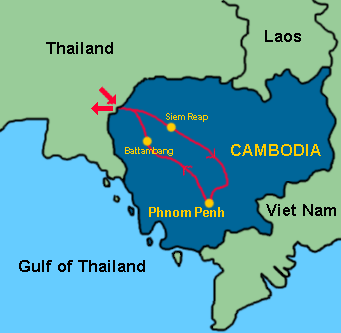 |
 |
full country name |
 |
Kingdom of Cambodia |
| capital |
 |
Phnom Penh |
| population |
 |
13.4 million (as of 2001) |
| surface area |
 |
181000 sq km |
| currency |
 |
riel, US$ |
| exchange rate |
 |
US$ 1 = riels 4000 (as of June 2003) |
| language |
 |
Khmer |
| main religion |
 |
95% Theravada Buddhist |
| Internet users |
 |
0.045% (as of 2000) |
 |
| Thieves & Scams: 0 kN/gM: 3 - Overall Winner: Poverty |
| Siem Reap. - On day four hundred and seventy seven, kN and gM were looking for cheap accommodation in Siem Reap. After the usual search, a nice double room with bathroom ... (more) |
 |
| Money Money Money Money |
|
Of the poorest countries we have travelled, Cambodia feels the poorest. We saw poverty in other countries such as Romania, Laos, Myanmar, and Thailand, but the poverty in Cambodia ... (more) |
 |
On May 23rd, 2003, we arrived in Cambodia, staying for eleven days before returning to Thailand on June 3rd, 2003. From the Thai border, we traveled to Siem Reap to visit the breathtaking Khmer temples and ruins of Angkor. During six days we saw a great deal, but not nearly all that there is to see. The most memorable impressions include the expansiveness and symmetry of Angkor Wat, the one to two meter high sandstone faces of Avalokiteshvara (or King Jayavaram VII) at the Bayon as they are slowly lit one after the other by the rising sun, the carvings at Banteay Srei as well as at the Terrace of Elephants and at the Terrace of the Leper King, huge trees growing over equally massive walls and entrance gates at Ta Prohm, Ta Som, and Preah Khan, and last but not least, the labyrinth-like corridors and courtyards of Ta Prohm and Preah Khan. We also visited the worthwhile Land Mine Museum, a private effort of a local deminer, which does not sacrifice realism for politics.
The remaining days were spent travelling to and from Phnom Penh, the capital of Cambodia, and in the city itself. The Tuol Sleng Museum, former Security Prison 21 and the largest center of detention and torture from 1975 to 1979, as well as the Killing Fields of Choeung Ek, the extermination site for and mass graves of about 17000 victims afforded us with a grim testimony of the brutal genocide by the Khmer Rouge. The Royal Palace, the adjacent Silver Pagoda, and the markets Psar Thmei, Psar Tuol Tom Pong, and Psar O Russei allowed us to have a less somber second day in Phnom Penh. On the way back to Thailand, we broke our journey for one night in Battambang, the second largest city in Cambodia.
|
 |


































